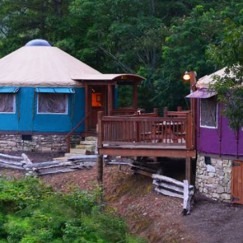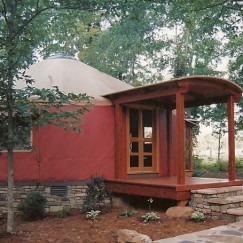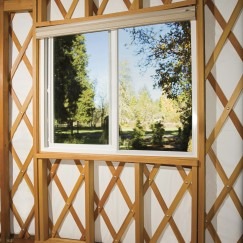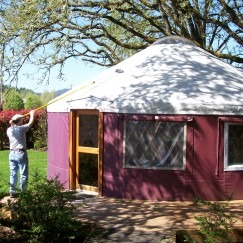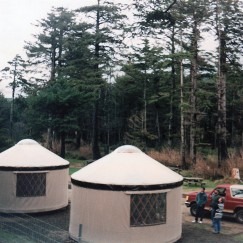Are Yurts Safe in Storms?
If you live in an area prone to extreme weather conditions, you’re probably wondering how safe you are staying in a yurt during a storm. We know weather is a concern for many yurt owners, and we’ve made sure to engineer a yurt that can withstand extreme weather conditions to comfort your concerns about yurt safety.
In fact, yurts are very resilient structures—especially when upgraded with snow and wind support kits. Their round shape means high winds can flow around the outside, putting less wind pressure on the structure than a rectangular building. Even Pacific Yurts‘ largest yurt can be enhanced to withstand roof snow up to 100 pounds per square foot and wind up to 142 miles per hour.
Our customers put our yurts to the test in some of the harshest climates from off-the-grid snow covered mountains, to intense sun soaked deserts. Their yurts withstand even the most severe weather conditions, and with the proper care and maintenance, they’ll continue to thrive where they live as safe places to stay.
Yurt Homes Are Built Strong![]()
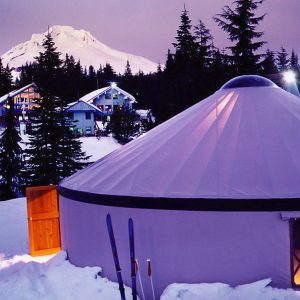
In general, yurts are very safe during storms. Many interconnected points in their structure, along with an aerodynamic shape, provide a high level of stability and flexibility. Pacific Yurts, in particular, are built to the highest standards for quality design and manufacturing, meaning we engineer them to be the strongest in the industry. We don’t just engineer our yurts for safety in perfect conditions. We engineer them to survive the demands of real-life weather conditions.
In addition to excellent design, quality materials are essential. Our yurt’s entire wood framework is made only from machine stress rated kiln dried Douglas fir and the proper grade of lumber is chosen for each individual component. For example, clear vertical grain lath is used for the lattice wall, which is fully riveted together and our rafters and center ring are made from select structural-grade lumber.
Of course, yurt users can take a number of preventative measures to stay out of harm’s way even further.
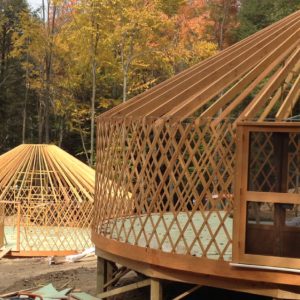
Making Yurts Even Safer During Storms
Before all else, make sure your yurt is properly assembled. We provide a detailed installation manual to keep the process easy, as well as a toll-free number in the United States to field any questions. If you prefer to hire a contractor or carpenter to do the set-up, but be sure they follow the instructions carefully and have them call us to answer any questions.
In areas prone to heavy snow or high winds, the Pacific Yurt can be upgraded for higher load conditions. Our snow and wind kit includes high-quality, kiln-dried supports, hardware and a cable blocking system to add rigidity and strength. We also offer perimeter blocking, made of prefinished 2×4’s installed between the vertical supports. Our cable tie-down provides even more protection from high winds by securing the center ring directly to the floor. Rafter, ring and hardware upgrades, as well as a central column of powder-coated steel, can provide increased snow load capacity.
A yurt doesn’t attract lightning any more than any other structure in the same location. We are only aware of one yurt that’s been struck by lightning. The strike melted some of the insulation, but didn’t harm anyone. We recommend consulting with someone who specializes in avoiding lightning strikes in your area.
Pacific Yurts has dominated the industry since 1978 with strong structures that last. The resilience of our yurts should leave you confident about taking that backcountry ski trip or staying by the ocean during rainy season. Contact us today for a quote.
Research Your Local Weather and Regulations
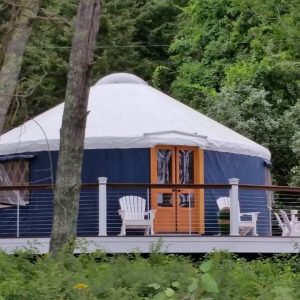
For business owners planning to start the yurt building process, doing some research beforehand can help your build go smoothly and avoid any weather-related issues for years to come. Be sure to research the local structure regulations in your area, as well as the up-to-date structural wind and snow loads. Snow load can vary greatly depending on how wet the snow is or whether it’s frozen, and local engineers will have the most accurate data for your area.
Regarding lightning, a yurt doesn’t attract lightning any more than any other structure in the same location. We are only aware of one yurt that’s been struck by lightning. The strike melted some of the insulation, but didn’t harm anyone. We recommend consulting with someone who specializes in avoiding lightning strikes in your area.
Build a Yurt That Lasts Today
Pacific Yurts has dominated the industry since 1978 with strong structures that last. The resilience of our yurts should leave you confident about taking that backcountry ski trip or staying by the ocean during the rainy season. Contact us today for a quote.
